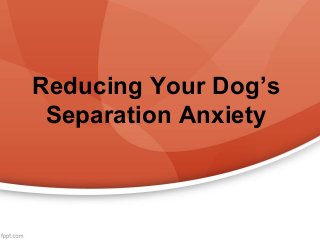
Reducing Your Dog’s Separation Anxiety
- 1. Reducing Your Dog’s Separation Anxiety
- 2. Introduction • Barking • Whining • Scratching and destroying property • Escaping from crate • Defecating/urinating in home Separation anxiety is a common condition that is exhibited by dogs in the event that the owner leaves them for a certain period of time. The dog is distressed and may display some of the following problem behaviours:
- 3. Introduction Not all dogs are the same and neither is every relationship between dog and owner. As such, techniques to overcome separation anxiety will have to be tailored for each specific case. Most cases require professional help but as a pet owner there are steps you can take to help alleviate some of your pooch’s separation anxiety.
- 4. Causes of Separation Anxiety There are several different causes of separation anxiety although sometimes it is difficult to pinpoint the exact origin. Over-indulgence is a typical cause of separation anxiety where the owner applies incorrect conditioning and the pooch is not used to being alone. The dog is stressed until reunited with the owner. Lack of exercise is also a common cause of separation anxiety, where high energy levels are maintained and not released. This energy, along with the mental anguish associated with separation results in problem behaviour.
- 5. Tip #1 You cannot expect your dog to overcome their anxiety immediately. As such, take small steps towards the larger goal. Initially, leave your dog alone for short periods of time and progressively increase the amount of time you spend away from your dog. Perhaps start with 5 minutes and continue extending the time period left alone.
- 6. Tip #2 Taking your dog for a walk prior to you leaving is a good way to allow your dog to release energy. Let your pooch rest and provide food and water before leaving them alone. You will notice that your dog is calm and less stressed as a result of the exercise.
- 7. Tip #3 Create a safe haven for your dog within the home. Use a kennel, small room or allocate a special area just for your dog to ensure that he feels comfortable and secure. Make this area more attractive by leaving food and toys for your dog.
- 8. Tip #4 Do not give in to your dog’s demands for attention before you leave your home. Attention-seeking behaviour includes things like: whimpering, dropping items at your feet, nudging or barking.
- 9. CONCLUSION Reducing separation anxiety is essential for a healthy, happy relationship between you and your pooch. Professional dog or puppy training may be beneficial depending on the extent of your pooch’s anxiety. Regardless, there are steps that you can take now to decrease the distress your dog experiences when you are away.
- 10. This presentation was prepared on the behalf of http://barkbusters.ca/
